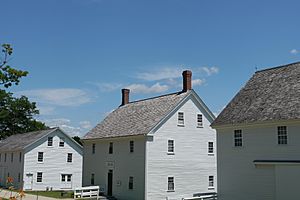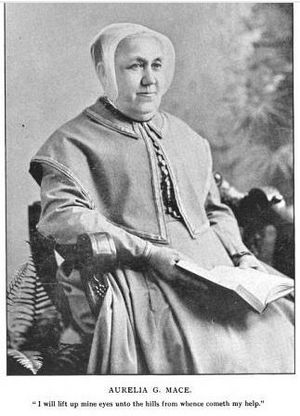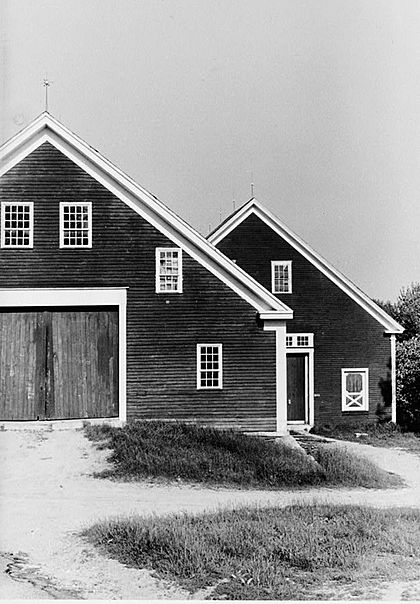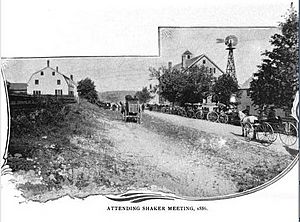Sabbathday Lake Shaker Village facts for kids
|
Sabbathday Lake Shaker Village
|
|

Shaker Library and schoolhouse
|
|
| Location | New Gloucester, Maine |
|---|---|
| Built | 1782, 1783, or 1793 |
| NRHP reference No. | 74000318 |
Quick facts for kids Significant dates |
|
| Added to NRHP | September 13, 1974 |
| Designated NHLD | May 30, 1974 |
The Sabbathday Lake Shaker Village is a special place in Maine, near the towns of New Gloucester and Poland. It is the very last active community of the Shakers, a unique religious group. As of 2025, three members live there. This village started a long time ago, around 1782 or 1783, when the Shaker movement was at its biggest in the United States. The main meetinghouse, where they gather, was built in 1794. Because of its history and importance, the entire village was named a National Historic Landmark in 1974.
Contents
Discovering the Shakers
The Shakers were a religious group that began in England in 1747. They started in the home of a woman named Mother Ann Lee. This group grew out of another religious group called the Quakers. Both the Shakers and Quakers believed that everyone could connect with God directly, without needing special priests or ceremonies.
Shakers were known for being very emotional and expressive during their worship. They also believed in living a perfect life, always saying sorry for their mistakes, and trying not to make them again. They didn't marry or have children, so new members joined their communities.
Shakers in America
In 1774, the Shakers moved to Colonial America to find religious freedom. They built 19 special communities where people lived and worked together. Over the next 100 years, about 20,000 people joined them. The first Shaker village was in New Lebanon, New York. Other communities were built in states like Maine, New Hampshire, Massachusetts, and Ohio. The Shaker group was largest around 1840, with about 6,000 members.
History of Sabbathday Lake Village
The Shaker community at Sabbathday Lake began in 1782. It was started by Shaker missionaries and was first known as Thompson's Pond Plantation. The first members came from Gorham, Maine. In less than a year, the community grew to more than 200 people.
Growth and Buildings
Sabbathday Lake was the most northern Shaker community. They built their meetinghouse in April 1794. Their first dwelling house, where they lived, was built across the road in 1795. By 1850, the community had grown to cover about 1,900 acres. It had 26 large buildings. These included the meetinghouse and the Brethren's Shop, which still has a working blacksmith shop.
The Shakers wanted to be as self-sufficient as possible. This means they tried to produce everything they needed themselves. They built a mill and a farm. This allowed them to sell food and other goods to people outside their community. A large new Central Dwelling House was built in 1883 or 1884.
Shaker Membership Over Time
In 1800, more than 140 people lived at Sabbathday Lake. By 1850, the number had dropped to about 70 Shakers. The 1880 census showed 43 members. This number stayed around the same until the 1930s, when only about 30 members remained.
The number of members continued to go down. However, the Sabbathday Lake Shakers welcome new people who want to join them. In 2025, Sister April Baxter joined, bringing the total number of Shakers in the community to three. The other members are Sister June Carpenter and Brother Arnold Hadd.
Open to New Members
In 1963, the Sabbathday Lake Shakers started holding their worship services for the public again. Today, membership to the community is still open. Sometimes, "novices" (people new to the idea) explore what it's like to join the society.
Life in the Twenty-First Century
As of 2006, the Sabbathday Lake Shaker Village has 14 working buildings. The Central Dwelling House is one of them. It has a music room, a chapel, a kitchen, and a large dining room. The community still holds regular public worship services on Sundays in the 1794 meetinghouse.
Important Buildings and Museum
The Shaker Library is another important building. It holds many Shaker records that help people learn about their history. Other historic buildings include the Cart and Carriage Shed, Ox Barn, The Girl's Shop, and the Herb House. There's even a garage built in 1910 for the community's first car!
The village has been open to visitors since 1931. That's when the Shaker Museum and Library was created. About 10,000 people visit each year. The Sabbathday Lake Shaker Museum has the largest collection of Shaker culture from Maine. It displays furniture, oval boxes, tools, and herbal products. The museum focuses on preserving the history of Maine Shaker communities.
Protecting the Village's Future
Since Shakers do not marry or have children, new members must join from outside the community. Many people find the idea of not marrying or having children a big challenge. The current members have worked hard to make sure Sabbathday Lake Village stays mostly the same for a long time.
Land Preservation Efforts
The Shakers own about 1,643 acres of land. This includes Sabbathday Lake, which has 5,000 feet of undeveloped shoreline. There is also a 150-acre Shaker Bog. To prevent their land from being sold for houses or other buildings, the Shakers took action in 2001.
They sold special agreements called preservation and conservation easements. These were sold to groups like Maine Preservation and the New England Forestry Foundation. These groups help protect the land. This means the village, farmland, and forests will be safe from development. Brother Arnold Hadd explained that they "can't put up a Wal-Mart. Or a housing development." The land must always be used for farming and forests.
How the Village Earns Money
Selling these development rights has helped the Shakers fix and maintain their village buildings. They also earn money by leasing out cottage lots on Sabbathday Lake. They lease about 1,000 acres of forests and 30 acres of farmland. Other income comes from making crafts, basket weaving, and printing. They also make small wooden items. Six year-round and six seasonal employees help run their operations.
Daily Life in the Community
The Sabbathday Lake community was one of the smaller Shaker groups. They spend their days farming and making various handicrafts. Their Shaker Museum and Sunday services are open to visitors. Every year, on the first Sunday of August, they celebrate Mother Ann Lee. This remembers when the English Shakers first arrived in America. They sing songs and share a special Mother Ann cake.
A Typical Day
Here is what a typical day looks like for a Shaker at Sabbathday Lake Village:
- The day starts at 7:30 am when the Great Bell rings for breakfast.
- Morning prayers begin at 8:00 am. They read from the Bible, pray together, and have silent prayer. They finish by singing a Shaker hymn.
- Work for the Shakers starts at 8:30 am.
- Work stops at 11:30 am for midday prayers.
- Lunch, which is their main meal, begins at 12:00 pm.
- Work continues at 1:00 pm.
- Supper, the last meal of the day, is at 6:00 pm.
- On Wednesdays at 5:00 pm, they have a prayer meeting. After that, they have a Shaker Studies class.
The members own all their property together. They also share their thoughts and confess their sins to each other. Many visitors come to the village. Brother Arnold and Sister June teach them how to make soap and bind books. The money from these workshops helps keep the village going.
The Shaker Trust Agreement
In 2005, the Shakers made an agreement with the state of Maine and several conservation groups. This was called a trust. It helps preserve their history and their beautiful lakeside property at Sabbathday Lake Shaker Village. Through this agreement, the Shakers sold conservation easements. This means the village will be protected from development. It can continue to operate as long as there are Shakers living there.
The agreement does not say what will happen to the property if the Shakers eventually die out. That decision would be made by a non-profit group called the United Society of Shakers, Sabbathday Lake Inc. Most of the people on its board are not Shakers. This conservation plan costs $3.7 million and relies on grants, donations, and public money.
See also








